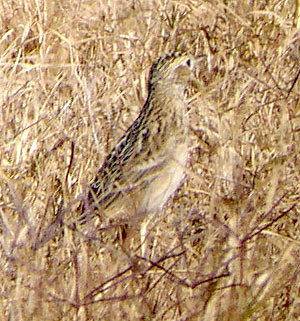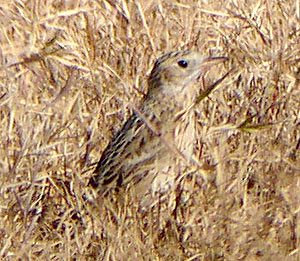
Sprague's Pipit
Calipatria, Imperial County, California
27 December 2002
Joseph Morlan
 This morning Robbie Fischer
and I decided to try for the Sprague's Pipits which had been reported in Calipatria. We arrived mid-morning under
clear skies and no wind. We drove along Peterson Road east from Blair Road along the south edge of the Calipatria
State Penitentiary until we found an access point just west of the first irrigated green field on the south side
of the road. We walked diagonally out into the short dry grass until I heard the distinctive "qweek qweek"
call of Sprague's Pipit behind me. I looked in the direction I heard the call and was surprised that the bird was
on the ground, not too far from me. I was able to get good views through my Kowa spotting scope. I called Robbie
on the radio, and she was able to find the bird and view it in her Nikon FieldScope.
This morning Robbie Fischer
and I decided to try for the Sprague's Pipits which had been reported in Calipatria. We arrived mid-morning under
clear skies and no wind. We drove along Peterson Road east from Blair Road along the south edge of the Calipatria
State Penitentiary until we found an access point just west of the first irrigated green field on the south side
of the road. We walked diagonally out into the short dry grass until I heard the distinctive "qweek qweek"
call of Sprague's Pipit behind me. I looked in the direction I heard the call and was surprised that the bird was
on the ground, not too far from me. I was able to get good views through my Kowa spotting scope. I called Robbie
on the radio, and she was able to find the bird and view it in her Nikon FieldScope.
The bird flew further out into the field. I pursued it and soon located two more Sprague's Pipits on the ground. They eventually flew back to the original area and I heard a third bird behind me while I was watching them, so I felt confident there were at least three Sprague's Pipits in the field. Robbie relocated one of the birds on the ground and I was able to photograph it through the Nikon scope with my new Olympus D-550 digital camera . This was my first attempt at "digiscoping" and I am quite pleased with the results you see here.
The following brief description is based on notes made while watching the birds:
A rather buffy colored pipit with a large round black eye standing out prominently against pale face and eyering. The eyering tended to blend in with the rest of the face, but projected back over the ear coverts and extended forward across the forehead. The ear coverts were darker brown with a somewhat chestnut coloration when seen in good light. The crown was quite dark, blackish with narrow buffy streaks, giving it a capped appearance, blending with the paler nape. The nape was more finely streaked with brown. A pale gray area extended from the side of the neck under the ear coverts. Single narrow whisker marks could be seen in the malar region.
The pinkish bill was dusky at the tip and along the culmen. It was thin, pointed, and slightly decurved.
The back was dark brown with indistinct whitish stripes. The wings were brown with buffy grayish brown fringes on the tertials. The wing coverts were tipped with a grayish-white but the overall pattern was rather faint. The legs were bright pink when seen in good light.
The breast was buffy with narrow brown streaks. The belly was whitish.
In flight I watched one of the birds drop directly into the grass and could see the tail had more white in it than American Pipit, with at least the outer two rectrices appearing entirely white. Otherwise no white was visible in the tail from above.
The birds walked deliberately in the grass. They bobbed their heads, but did not pump their fairly long tails. They never came out into the open the way the American Pipits did which were often seen close to the road. The Sprague's Pipits did not seem to associate with other species, mostly keeping to themselves.
These are my third Sprague's Pipits in California. My first was in October 1975 in the Tijuana River valley. I also saw five birds which wintered near Lancaster, Los Angeles County in January 1982.